An athletic field study commissioned by Parks & Rec was posted to the Town of Greenwich website on Friday, Feb 5.
The 110+ page report is the work of consultants Weston & Sampson out of Rocky Hill, CT. They were hired in 2019 to assess town fields and offer recommendations.
The report concluded that Greenwich has insufficient athletic playing fields – particularly of rectangular fields – and a surplus of baseball fields. It also said that existing fields are overused, turf was stressed, and users were frustrated.
The report notes the fields shortage is exacerbated by field closures due to poor drainage, the Western Middle School field closure that was triggered by discovery of contamination, lack of field lighting, and impending remediation at GHS. (Fields at GHS, WMS, New Lebanon and Hamilton Ave School were not part of the field study)
No surprises yet.
The report suggested Greenwich consider acquiring properties for additional fields.
Would be nice.
The study also proposes parking lots, tree removals, ADA accessible pedestrian walkways between parking lots and fields and the addition of at least two synthetic turf fields.
“Surrounding communities have moved to the use of synthetic turf fields to support the expansion of their field-based playing venues due to dramatically increased rates of participation in youth sports and the expanding participation rate of women and girls in general.”
Weston & Sampson Athletic Field Study and Capital Improvement Plan
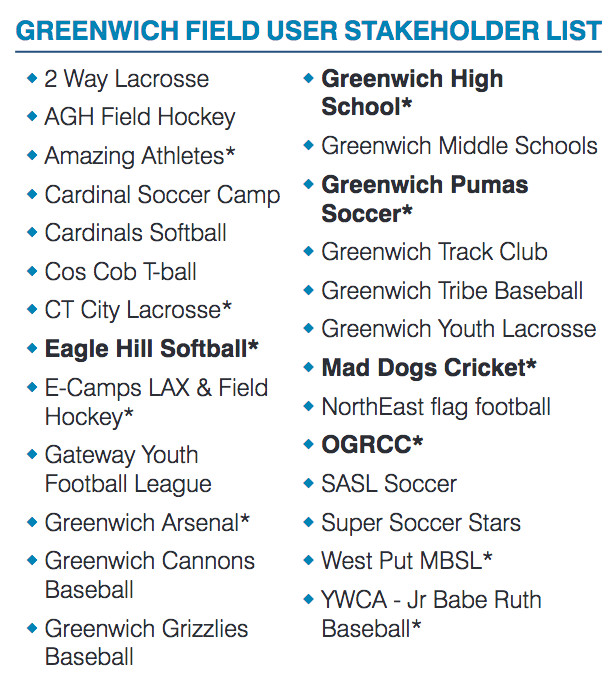
The report suggests the “remote location” of North Street School’s field (abuts cemetery) might be suitable for field lights and synthetic turf.
Here we go again.
That the notice was posted to the town website on the Friday before a school vacation week which raised some eyebrows.
Once the study began to circulate, residents were surprised that the consultants mainly sought input from field user groups and their members.
Kate LoBalbo who is a member of the RTM and a lifelong resident of Cos Cob, said the discussions were not inclusive enough, and that input from residents who use the parks for passive recreation – people jogging or perhaps walking dogs – was not incorporated into the study.
“The study excluded the stakeholders who are the neighborhoods that surround these spaces,” Lobalbo said. “This report only envisions the stakeholders as the athletic groups. Therein lies the conceptual misstep.”
Parks & Rec board co chair Scott Johnson, who is also a member of the fields committee, explained that the report was commissioned for roughly $75,000, and was in response to resident’s complaints about the poor quality of the town’s fields.
Certainly, anyone who attended the public hearing in June 2019 to give input for the new Eastern Greenwich Civic Center will recall that dozens of parents and athletes tried over and over to comment on the civic center’s fields, but were reminded by that was not the topic of the forum.
Mr. Johnson said the study was not an actual plan, but rather the opinion of engineers on what it would take to improve Greenwich’s fields.
He noted that bringing a field up to standard, including for example, spectator seating, player benches, backstops, dugouts and other amenities, would make it more attractive to users and potentially trigger requirements for parking, ADA accessibility and storm water management.
“It’s a study that requires a lot more work,” Mr. Johnson said. “There’s not even an inkling of an idea that we’ll start to effectuate the recommendations or agree with them. In many cases it will require more work, and it’s not anywhere near our capital plan.”
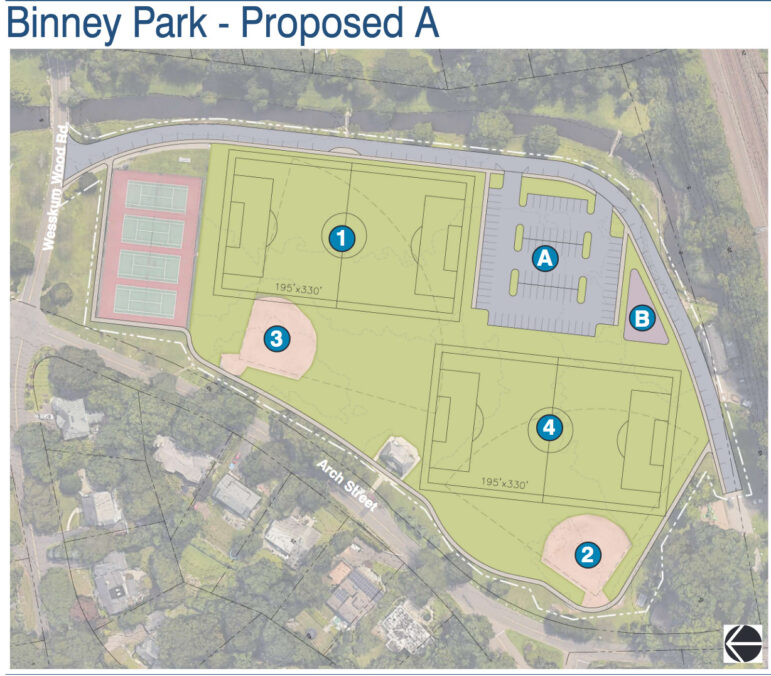
One of the study’s recommendations for Binney Park in Old Greenwich, “Proposed A,” is to remove one of the three baseball fields to allow for a bigger rectangular field and add a parking lot for 90 cars. There would also be a storm water management area and ADA accessible pathways to connect parking areas to fields.
Irrigation
The study notes that the town practices organic lawn care at public schools and parks, but noted that while that practice results in environmental and human health benefits, it requires additional maintenance. It notes there are no irrigation systems for town fields, which would add stronger turf, fewer weeds, softer soil and reduced potential for injuries.
The study recommends the town install irrigation at all natural grass field locations and increase the annual maintenance budget for fields.
Drainage
The report notes that poor drainage damages fields, and causes slippery and unsafe conditions, as well as canceled games and practices. When play occurs on saturated fields, the turf can be damaged permanently.
The report says the most effective way to improve drainage of a natural grass turf field is with a full-depth reconstruction with proper soil composition, grading, and a sub-drainage system.
However, the report also notes this can be cost prohibitive and take a field off-line for two or more growing seasons. The study says a less expensive approach would be to create 2” trench drains, verti-drain aeration, verti-quake sand injection slits.
Lighting
Currently, only Tuefel Field in Byram and GHS Cardinal stadium have sports lighting, and Cardinal Stadium has very limited use of lighting.
The report recommends installing sports lighting wherever synthetic turf is installed, and notes that advances in lighting technology result in much less light spillage and glare seen by neighbors.
The report acknowledges that Greenwich would have to either issue zoning variances on a site-by-site basis or change zoning regs to allow for sports lighting in certain zoning districts where fields are located.
In addition to renovating fields with improvements including grading, drainage, irrigation and turf establishment, proposals include relocating baseball fields such as the one at Glenville School for optimal solar orientation.
At Moretti Field on Bible Street in Cos Cob, one proposal is to remove the baseball field to eliminate a longstanding foul ball issue with adjacent houses and parking lot. Also to relocate the playground, basketball court and ball field, which would require extensive rock removal.
At Old Greenwich School the proposal is to remove one of the two ball fields and relocate the remaining ball field to accommodate a full-size, multi-use rectangular field.
At ISD the proposal is to remove the existing baseball field to allow for a larger rectangular multi-use field.
At Western Greenwich Civic Center, in addition to field improvements, one of two proposals is to remove the softball field to allow for a full-size rectangle field, relocating the existing playground, expanding parking for 197 on-site parking spaces
The study notes that while natural turfgrass is proposed, the site and recreational programming at the civic center would benefit from a synthetic turf surface. Synthetic turf will maximize field usage and provide opportunity for stormwater storage. Also, field lighting could maximize field use and programming and requires further consideration
In the field at Bruce Park, which is mainly used for softball, the study noted there was less use by rectangle sports because of grading issues. They proposed a parking lot with 50 spaces, as well as separation between spectator seating and passing traffic, and pathways from parking to field and spectator seating. There is also a tree “conflict” by the backstop, which would be remedied by removing the tree.
At Christiano Park in Chickahominy, the consultants recommend relocating the existing baseball infield for a better solar orientation. In one option, the consultant proposes adding an off street parking lot for up to 50 cars.
At Eastern Greenwich Civic Center where 3.5 out of 13 acres are dedicated to fields, there is a large softball field, one full size soccer or lacrosse field overlay and a small size soccer field overlay.
The consultant’s report said drainage and turf conditions were poor in places and there was a possible high water table. The right field has frequently flooded. Settlement over time was reportedly due to buried tree stumps. Also overlapping fields have created scheduling conflicts. There is a Beaver problem in adjacent wetlands/watercourse, and a small outlet at the railroad tracks exacerbates field flooding. There are also parking issues when the civic center is utilized concurrently with field use times.
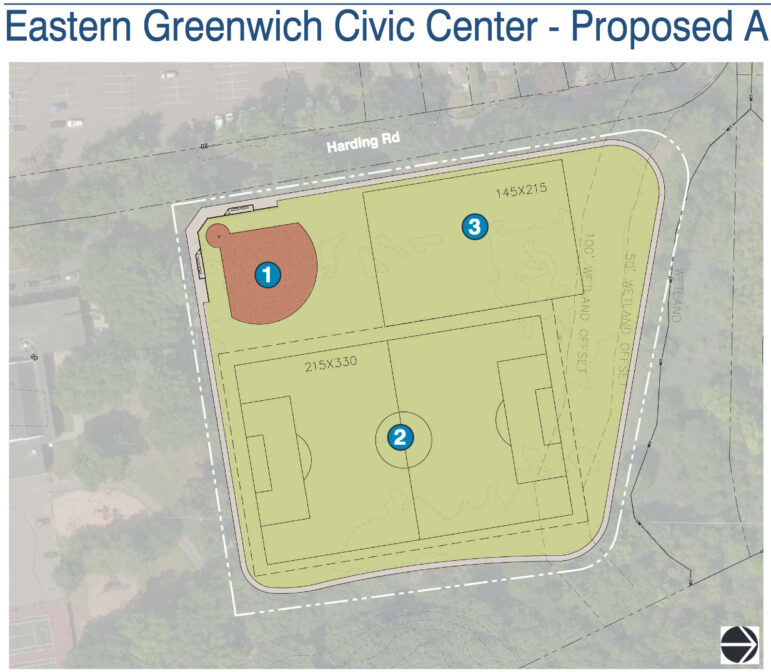
Proposed A would relocate the softball infield toward Harding Road for optimal field orientation and drainage to shed away from the infield.
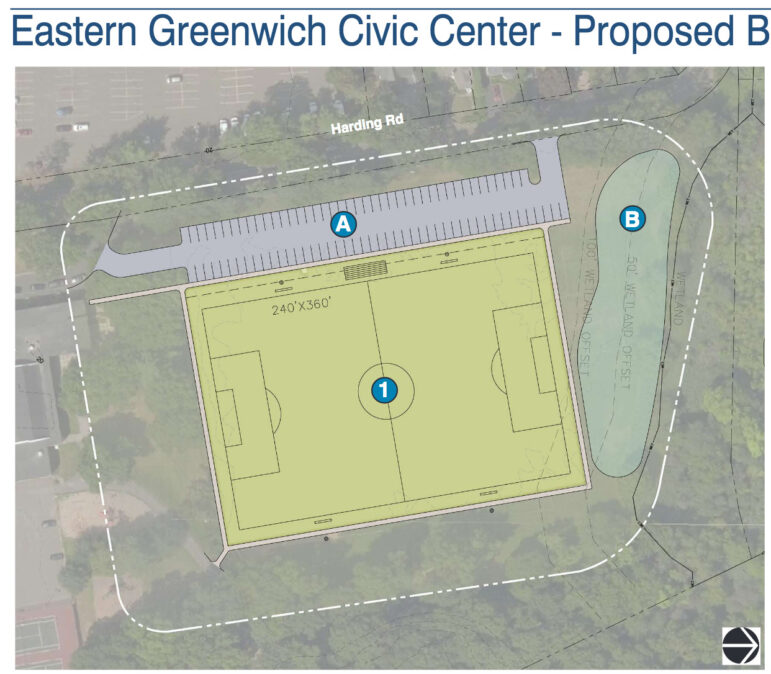
Proposed B would eliminate the softball field, construct a dedicated, full-size, lighted, rectangle field, create a parking lot for about 80 cars, add a possible stormwater management area and create ADA accessible pedestrian walkways and loop trail. Proposed field improvements include a gravel blanket, field under drainage, rootzone, seeding, irrigation and turf establishment.
The report said further exploration was needed to determine suitability of synthetic turf at Eastern Greenwich Civic Center.
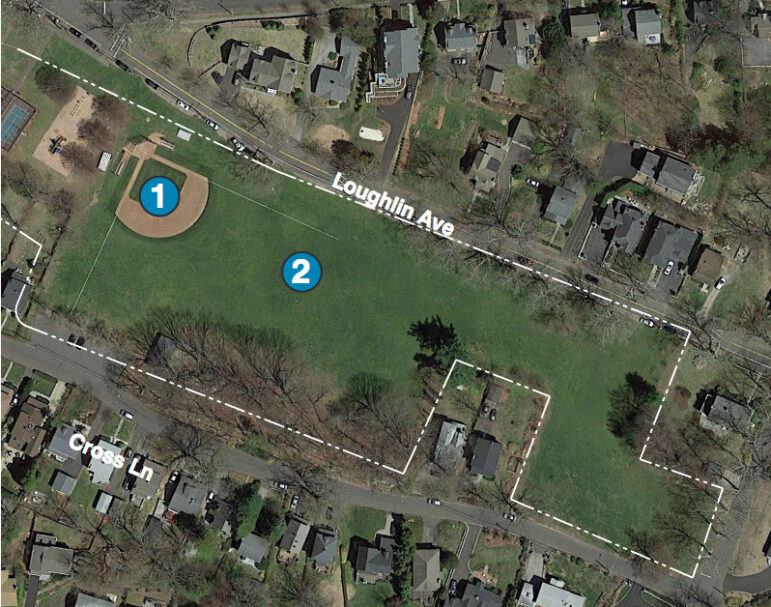
Loughlin Avenue Park
At Loughlin Ave Park where 2.4 acres our of 5.6 acres are used for fields, the consultants acknowledge the site is “a true neighborhood park surrounded by residential areas.”
Concerns include the lack of an ADA accessible route, poor drainage, close proximity to houses and limited on street parking.
The site currently features a youth baseball field, a rectangle field overlay and a small rectangle field.

Loughin Ave Park Proposed A
“Proposed A” features a fully fenced in little league complex with two ball fields. The second little league field would have a 200’ outfield so both baseball fields could operate at the same time.
Field 1 improvements would include field underdrainage, rootzone, seeding, infield mix, irrigation, turf establishment, player bench areas and backstop.
Adding the second baseball field would require tree removals.
The proposal includes a parking lot for 70 cars.
There would be a stormwater management area (B) (for increased impervious surface) located next to a proposed concession stand, rest room pavilion and splash pad (C).
Proposed A would also create ADA accessible pedestrian walkways to the fields.
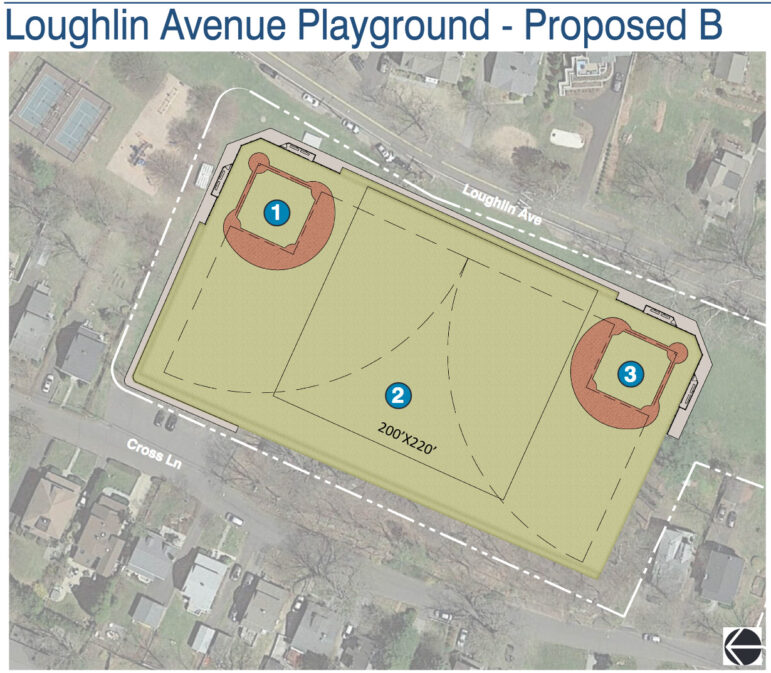
Loughlin Ave Park Proposed B
Proposed B would also feature a second youth ballfield and a fully fenced little league baseball complex. The difference is that they would be spread further apart and there would be no concession restroom pavilion, splash pad or stormwater management area.
Mr. Johnson said going forward, the next step will likely be for agencies involved to ask Parks & Rec Dept ask for their long term master plan.
“The study is a resource. It’s in response to a request to do some initial analysis on the fields so we can better address on short term and long term basis,” he added. “The most common complaint we get is about the poor quality and shortage of playing fields. That doesn’t mean we turf of the universe; it’s about what the engineers say.”